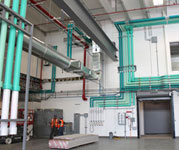For the first time, a research facility will be dedicated to integrating renewable energy to the grid at utility-scale.
Sited on the campus of the Department of Energy’s National Renewable Energy Lab (NREL) in Golden, Colorado, the Energy Systems Integration Facility will help public and private sector researchers scale promising clean energy technologies – from utility scale solar and wind to electric vehicles and efficient, interactive home appliances – and test how they interact with each other and the grid at utility-scale.
Research also includes next generation building technologies, microgrids and energy storage batteries.
The idea is for manufacturers, utilities and researchers to work together to integrate renewable energy into a smarter, more reliable and more resilient power grid. The goal is to overcome generation, transmission, distribution and end-use challenges to support a cleaner, affordable and more secure US energy mix.
Doesn’t look like much, but this is grid integration technology:

The 182,500-square-foot building will house more than 15 experimental labs and several outdoor test beds, including an interactive hardware-in-the-loop system that lets researchers and manufacturers test their products at full power and real grid load levels. A "petascale" supercomputer supports large-scale modeling and simulation at one quadrillion operations per second.
"This is an excellent example of the impact that federally-funded research can have on solving national problems beyond the scope of private investment. And, it demonstrates the importance of partnerships among the federal government, industry, and academia," says NREL Director Dan Arvizu.
One industry partner has already signed up – Colorado-based Advanced Energy Industries will start work there to develop lower cost, better performing solar PV inverters.
It will make use of the facility’s utility-scale grid simulators to develop inverters that can handle two-way flows of power and communication while reducing hardware costs.
The Department of Energy’s national network already serves 30,000 scientists and engineers giving them access to some of the world’s most advanced technologies, such as x-ray sources, accelerators and supercomputers. Corporate users pay the full cost of conducting research and retain their intellectual property and data rights, while users who agree to publish their research results get a discount fee.

